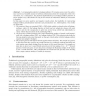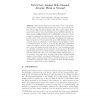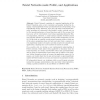5 search results - page 1 / 1 » Leakage-Resilient Pseudorandom Functions and Side-Channel At... |
CRYPTO
2010
Springer
13 years 5 months ago
2010
Springer
Abstract. A cryptographic primitive is leakage-resilient, if it remains secure even if an adversary can learn a bounded amount of arbitrary information about the computation with e...
EUROCRYPT
2009
Springer
14 years 5 months ago
2009
Springer
A weak pseudorandom function (wPRF) is a cryptographic primitive similar to ? but weaker than ? a pseudorandom function: for wPRFs one only requires that the output is pseudorandom...
CHES
2011
Springer
12 years 4 months ago
2011
Springer
Randomness extractors are important tools in cryptography. Their goal is to compress a high-entropy source into a more uniform output. Beyond their theoretical interest, they have ...
EUROCRYPT
2007
Springer
13 years 10 months ago
2007
Springer
Feistel Network, consisting of a repeated application of the Feistel Transform, gives a very convenient and popular method for designing “cryptographically strong” permutations...
ASIACRYPT
2004
Springer
13 years 10 months ago
2004
Springer
Abstract. Even and Mansour [EM97] proposed a block cipher construction that takes a publicly computable random permutation oracle P and XORs different keys prior to and after appl...



